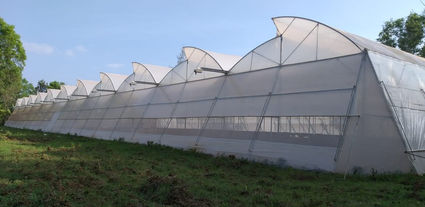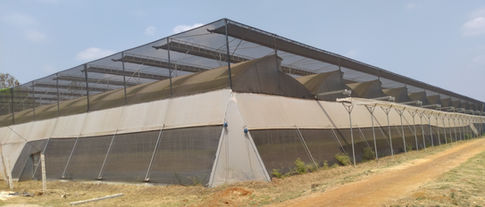+91 8848166393

PROTECTED FARMING

NVPH Polyhouse

Fan and Pad Polyhouse

Round/Dome top shadenet

NVPH Polyhouse
Protected farming is one of an advanced method of crop cultivation, where the crops cultivated in a closed chambers made with Glass / Poly-film, Shade nets or it may be any building. Per the history a greenhouse concept was very much in existence in Rome and Korea (ie., 14th century) . During 17th century in Netherland and England there were few greenhouses, In the 18th century the French botanist Charles Lucien Bonaparte is often credited with building the first practical modern greenhouse in Leiden, Holland. there are records to prove greenhouse cultivation in Japan too during 1880. In the 20th century geodesic dome was introduced in the greenhouses. during 1960 Polytethylene sheets started to use as a top covering, these greenhouses constructed of aluminum extrusions, special galvanized steel tubing, or even just lengths of steel or PVC water pipe, construction costs were greatly reduced, these greenhouses popularly known as polyhouses / hoophouses.. During 1980-90 gutters were introduced ,greenhouses have two or more bays connected by a common wall. proper ventilations on top and sides were introduced. Currently the polyhouses / greenhouses are well equipped with smart agriculture systems this to create very conducive microclimate to grow crops, this comprises IoT based Sensors to automatically regulate temperature, humidity, light intensity, shading, irrigation and fertigation. A Semi / full control environment agriculture results multiple times of yield with superior quality and reduce crop cycle duration.
Pros and cons of the Polyhouse
Pros
-
Can create the conducive microclimate to facilitate grater growth of the crops.
-
grow the crops around a year (off season)
-
More productivity in lesser area and the crop duration.
-
Produce greater quality crops.
-
Optimum utilisation of an inputs and water
-
Easy management
-
less manpower requirement
-
Easy in Pest and disease control
Cons
-
Initial investment is high
-
Recurring charges are high
-
prone to high temperature, humidity and pest attacks
-
Mixed results in tropical and subtropical regions
Protected farming in India
In India under National Horticulture Board (NHB), National Horticulture Mission (NHM), Mission for Integrated Development of Horticulture (MIDH), Rashtriya krishi vikas yojana (RKVY), and Horticulture Mission for North East Himalayan states (HMNEH), both central and state governments are providing subsidy on setup of Polyhouses/ Net house / Bamboo poly/net houses. the subsidy availability is subjected to respective states under NHM and the subsidy ranges from 50% to 100% based on different parameters (Region / Caste/Reservations etc..). Subsidy is available on Polyhouse, irrigation and planting materials too. Under NHB, minimum area to get the subsidy for the polyhouse is 2600 Sqm, whereas under NHM,MIDH and HMNEH there is no such restrictions. One can go for minimum 250 Sqm to Maximum 4000 Sqm.









